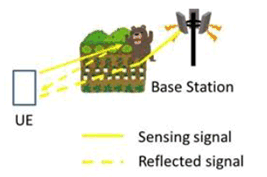Content for TR 22.837 Word version: 19.3.0
0…
4
5…
5.2…
5.3…
5.4…
5.5…
5.6…
5.7…
5.8…
5.9…
5.10…
5.11…
5.12…
5.13…
5.14…
5.15…
5.16…
5.17…
5.18…
5.19…
5.20…
5.21…
5.22…
5.23…
5.24…
5.25…
5.26…
5.27…
5.28…
5.29…
5.30…
5.31…
5.32…
6…
7…
5.6 Use case on intruder detection in surroundings of smart home
5.6.1 Description
5.6.2 Pre-conditions
5.6.3 Service Flows
5.6.4 Post-conditions
5.6.5 Existing features partly or fully covering the use case functionality
5.6.6 Potential New Requirements needed to support the use case
...
...
5.6 Use case on intruder detection in surroundings of smart home p. 25
5.6.1 Description p. 25
Detection of an intruder including a person or a harmful animal into a private property is an important piece to ensure residents at home in the private property feel comfortable and secure. For the surroundings monitoring, various technologies, such as cameras, infrared cameras, and microwave radars are being used. However, these technologies require line-of-sight, and therefore locations which can be monitored may be limited.
Wireless signals make it possible to monitor locations without line-of-sight and to monitor wider areas [17]. Sensing by wireless signals can complement the afore-mentioned technologies and can improve accuracy of the detection. Sensing by wireless signals gives residents time to prepare against intruders or to drive them away.
5.6.2 Pre-conditions p. 26
UEs such as smart phones and consumer premise equipment are installed inside a house, in particular, near a wall or a window. Residents have a contract with a mobile operator for the UEs.
5.6.3 Service Flows p. 26

- The UEs such as smart phones and CPE communicate with base stations in the outdoor or in the indoor and monitor 3GPP signals which are influenced by outdoor objects such as humans and animals. In addition, the UEs communicate with base stations of the mobile operator and monitor the radio wave state between the UEs and the base stations.
- When an intruder enters the site, the radio signals are changed. The core network processes the data and yields sensing result indicating detection of the intruder.
- The residents are informed of detection of the intruder.
5.6.4 Post-conditions p. 26
The residents report to the police or the security service and request them to take an appropriate action.
5.6.5 Existing features partly or fully covering the use case functionality p. 26
None.
5.6.6 Potential New Requirements needed to support the use case p. 26
[PR 5.6.6-1]
Subject to operator policy, the 5G system shall be able to collect 3GPP sensing data and yield sensing result from the data for detection of outdoor objects.
[PR 5.6.6-2]
The 5G system shall be able to support the following KPIs:
| Scenario | Sensing service area | Confidence level [%] | Accuracy of positioning estimate by sensing (for a target confidence level) | Accuracy of velocity estimate by sensing (for a target confidence level) | Sensing resolution | Max sensing service latency[ms] | Refreshing rate [s] | Missed detection [%] | False alarm [%] | |||
|---|---|---|---|---|---|---|---|---|---|---|---|---|
| Horizontal
[m] |
Vertical [m] | Horizontal [m/s] | Vertical [m/s] | Range resolution [m] | Velocity resolution (horizontal/ vertical) [m/s x m/s] | |||||||
| intruder detection in surroundings of smart home | Outdoor | 95 | ≤2 | N/A | N/A | N/A | N/A | N/A | ≤1000 | < 1 | < 0.1 | < 5 |
|
NOTE:
The terms in Table 5.6.6-1 are found in clause 3.1.
|
||||||||||||